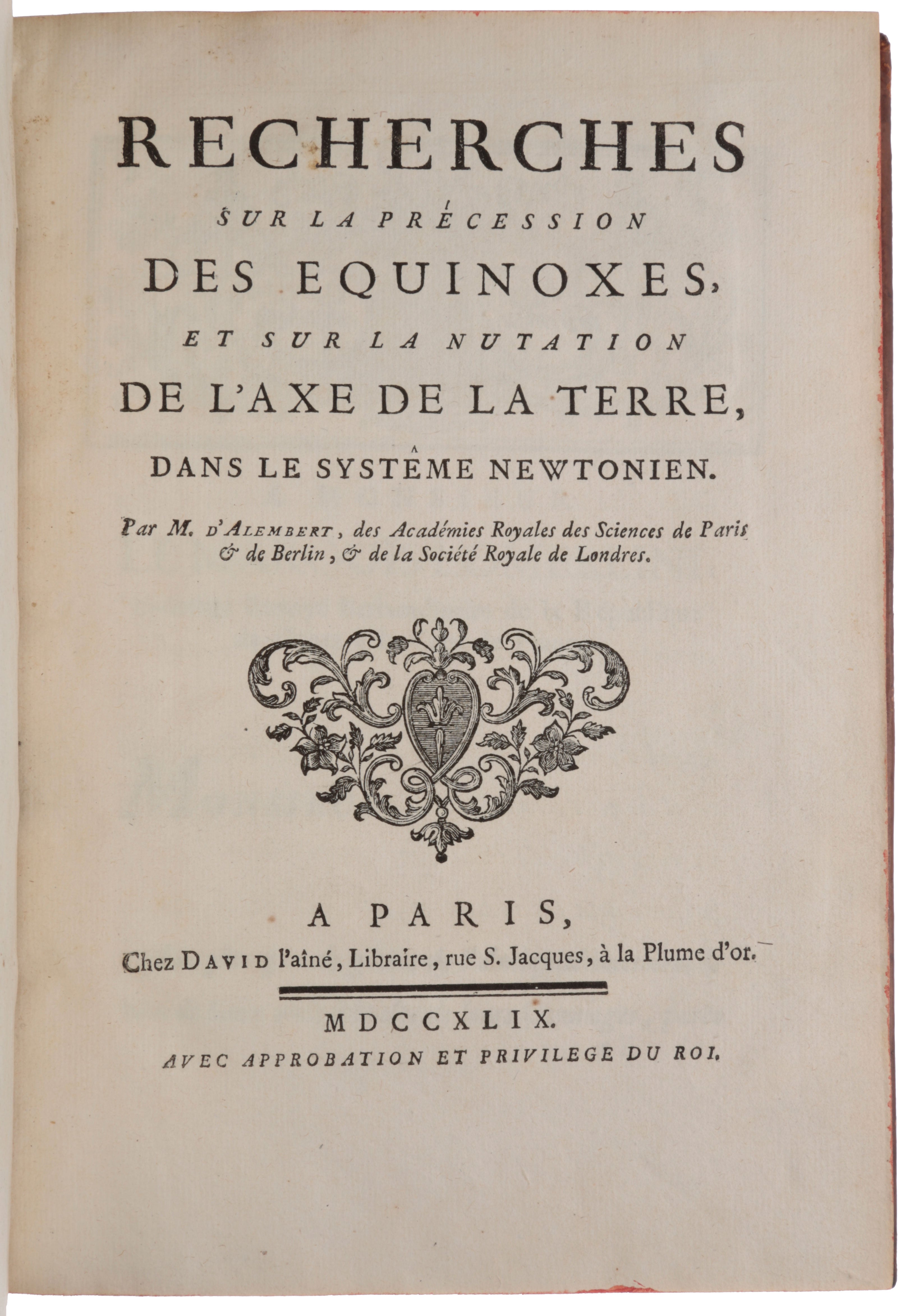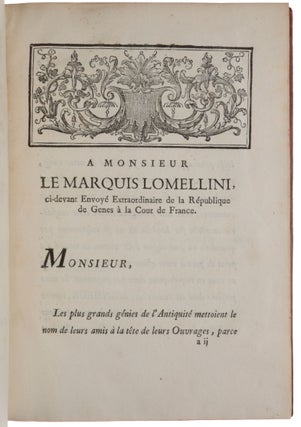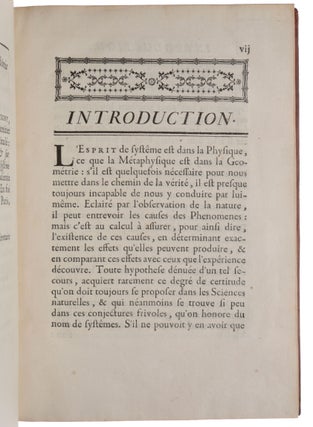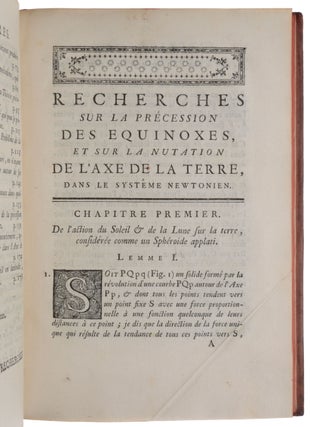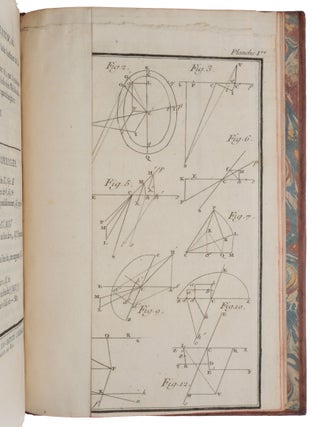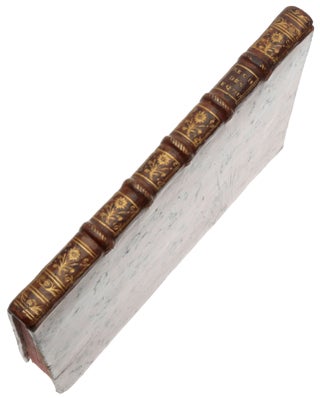Recherches sur la précession des equinoxes, et sur la nutation de l’axe de la terre, dans le système Newtonien.
Paris: David l’ainé [Colophon: De l'imprimerie de Jean-Baptiste Coignard, imprimeur du roi], 1747. First edition of one of d’Alembert’s most important books, widely regarded as the foundation work of the dynamics of rigid bodies. “The precession of the equinoxes had been observed in antiquity by Hipparchus. Newton explained the cause, the astronomer Bradley detected the nutation in a series of extremely accurate observations, and d’Alembert deduced the motion from the theory of gravitation” (Hankins, p. 30). “During the late 1740s, d’Alembert, Clairaut, and Euler were all working on the famous three-body problem, with varying success. D’Alembert’s interest in celestial mechanics thus led him, in 1749, to publish a masterly work, the Recherches sur la précession des equinoxes, et sur la nutation de l’axe de la terre. The precession of the equinoxes, a problem previously attacked by Clairaut, was very difficult. D’Alembert’s method was similar to Clairaut’s but he employed more terms in his integration of the equation of motion and arrived at a solution more in accord with the observed motion of the earth. He was rightly proud of his book” (DSB). “It was Isaac Newton who first proposed a quantifiable cause for the precession of the equinoxes: namely, the gravitational action of the Sun and Moon on the equatorial bulge of the Earth. When Newton attempted a strict quantitative derivation of the precession, however, he fell into serious errors, above all by supposing that finite rotations could be superimposed on one another by simple addition. The first to give an essentially correct derivation was d’Alembert, in his Recherches sur la précession des equinoxes published in July 1749. Twenty-four years later, Laplace, in the first memoir that he submitted to the Académie des Sciences, in introducing ‘the general equations of movement of a body of any figure, acted upon by any forces’, wrote as follows: ‘M. d’Alembert was the first to give the general solution of this problem, along with the most direct method of arriving at it, in his excellent treatise Sur la précession des equinoxes, an original work that shines throughout with the genius of invention, and that one can regard as containing the germ of all that has been done since on the mechanics of solid bodies’” (Wilson, pp. 232-3). Truesdell has stated that the theory of rigid bodies was Euler’s “single-handed creation,” but comparison of Euler’s ‘Discovery of a New Principle of Mechanics’, presented to the Berlin Academy on 3 September 1750, with d’Alembert’s Recherches of 1749, shows that Euler’s first successful resolution of the problem of the rotation of rigid bodies relies on a ‘lofty rule’ that had first appeared in d’Alembert’s Recherches. Provenance: Ernest François Louis de Courtilloles (1834-89) (armorial bookplate). If the Earth were not acted upon by any external forces, its axis of rotation would remain in a fixed direction in space (this is a consequence, in modern terminology, of the law of conservation of angular momentum). But the Earth is, in fact, subject to the gravitational effects of other bodies, principally the Sun and Moon. This causes a regular motion of the Earth’s axis, a periodic effect that repeats approximately every 26,000 years – this is called the precession of the equinoxes. As the Earth orbits the Sun, its distance from other celestial bodies varies and this causes shorter-term changes in the orientation of the Earth’s axis, which are referred to as nutation. A precise knowledge of these effects is important because the position of astronomical objects is expressed by reference to the mean equinox and equator, which are defined by the orientation of the Earth’s axis. The English astronomer James Bradley (1692-1762) “announced his discovery of the nutation in a letter dated 31 December 1747, which appeared in the Philosophical Transactions of the Royal Society of London for January 1748. Copies of the letter reached the Continent in the following summer, and La Caille, having translated it, read an extract of it to the Académie des Sciences. It is this reading that must have first interested d’Alembert (1717-83) in the problem of deriving the precession and nutation from the inverse-square law of universal gravitation … Writing to Euler on 7 September 1748, d’Alembert reported that the quantity of the nutation implied by the law of gravitation appeared to be larger than Bradley’s observational value; ‘however,’ he admitted, ‘to be absolutely certain of this, I believe I must examine this matter again with care’ … From December onwards, d’Alembert … devoted himself full-time to the problem of the precession and nutation. Of this endeavor he informed no one save Gabriel Cramer in Geneva; he was concerned lest he be anticipated by the English (Bradley’s letter had described a theory of the nutation and inequality of the precession due to John Machin, but without any indications as to how the theory had been derived). An undiscovered error in his calculation delayed him for a time; but he at length located the mistake, and was able to present his completed manuscript to the Académie des Sciences on 17 May 1749 … “D’Alembert regarded his solution of the problem as a striking confirmation of the theory: ‘The nutation of the terrestrial axis, confirmed by both the observations and the theory, furnishes, it seems to me, the most complete demonstration of the gravitation of the Earth toward the Moon, and consequently of the tendency of the principal planets toward their satellites. Previously this tendency had not appeared to be manifest except in the tides of the sea, a phenomenon perhaps too complicated and too little susceptible to a rigorous calculation to be able to reduce to silence the adversaries of reciprocal gravitation.’ “At an early stage of his attack on the problem of precession, d’Alembert made a study of Newton’s treatment of this problem. Indeed, no other treatment of the subject was available from which guidance might be extracted. D’Alembert’s Recherches sur la précession, which became a vindication of the Newtonian theory of gravitation, also contains the first thorough critique of Newton’s attempt to derive the precession. A review of this critique will enable us better to judge what d’Alembert accomplishes. “Newton’s qualitative understanding of the cause of precession emerged out of his study of the perturbations of the Moon, from the analogy between the retrogression of the Moon’s nodes and the retrogression of the equinoctial points. That the nodes of the Moon’s orbit must retrogress on the ecliptic owing to the action of the Sun follows from Corollary 11 of Proposition 66 of Book I of the Principia, and Newton derives the same effect quantitatively in Proposition 32 of Book III. If the Moon were multiplied so as to become many Moons, and these were liquified and joined so as to form a fluid ring, Newton says, the nodes of the ring would retrogress in exactly the same way as the nodes of the lunar orbit (Corollary 18 of Prop. 66 of Book I); and he hypothesizes further that the result will be the same if the ring becomes solid (Hypothesis II of Book III in the second and third editions). These conclusions, according to d’Alembert, who states that he checked them by a strict analysis, are not exact, but not so in error as to produce the error of Newton’s conclusion. “Newton’s next step was to consider a smaller ring, with radius equal to that of the Earth, and period equal to the diurnal period of the Earth, when subject to the same perturbative action as the Moon. The retrogression of the nodes of this ring, Newton asserts (on the basis of Corollary 16 of Proposition 66 of Book I), will be to that of the Moon or of the ring with which Newton imagines it to have been replaced, as their periods. D’Alembert confirms this conclusion. “If the ring is now attached to the Earth, it will evidently share its motion with the whole body of the Earth, but in accordance with what quantitative rule will this sharing take place? The quantity of matter in the ring Newton takes to be equal to the matter in the equatorial bulge of a spheroidal Earth; the thickness of the bulge at the equator he takes to be 1/230th of the Earth’s radius, a value derived from the assumption that the Earth is homogeneous and has assumed an equilibrium shape under the forces of rotation and gravity. In addition, Newton then assumes that the total quantity of motion that existed in the ring in virtue of the retrogression of its nodes is distributed between the ring and the underlying sphere, once the two are attached, in just the way required if the two bodies are to rotate together. The operative assumption here is conservation of quantity of motion or linear momentum, but Newton does not make this explicit. “What Newton should have done, d’Alembert points out, is to set the moment of the motion lost by the ring equal to the moment of the motion gained by the underlying sphere; in other words, he should have assumed the conservation of what we now call moment of momentum, or angular momentum. Because of this error, Newton’s result for the angular velocity transferred to the Earth is too large in the ratio of 15π2 to 128, or by about 16%. “D’Alembert also believed that Newton’s value for the flattening of the Earth, 1/230, was too small; the measurements of meridian arcs in Lapland and Peru, made by the French expeditions sent out in the 1730s, implied a value, he says, of 1/178. The latter value was consistent neither with a homogeneous spheroidal Earth nor with the more plausible supposition of a spheroidal Earth with density increasing toward the center; Clairaut had pointed out that the meridian measures could be sufficiently in error to yield a value less than 1/230. D’Alembert nevertheless held to the value 1/178, and attempted to reconcile it with the theory by supposing that it pertained only to the watery covering of the Earth, which would not, he assumed, influence the precession; the inner solid core of the Earth could have a flattening less than 1/230. Laplace later showed that the oceans have the same effect upon the precession as they would if solidified; and a re-measurement of the degree in Lapland showed that the original measurement had been considerably in error, the correct value for the flattening being in the neighborhood of 1/300. “A sphere with an attached equatorial ring is, of course, a different thing from a spheroidal Earth, and Newton recognized that the Sun’s attraction would have a greater effect on the former than on the latter, in causing the equinoctial points to retrogress. In the first edition of the Principia he took the ratio of the two effects to be 4:1; in the second edition he shows by a correct deduction that it is 5:2. But he then assumes that the motions engendered will be as the forces. D’Alembert objects: the movements produced by two different forces, when applied to masses that are equal but of different figure, depend on the figure, as experience with different distributions of mass along a lever-arm shows. To use an Eulerian term – never adopted or used by d’Alembert – the moment of inertia of the equatorial bulge differs from that of an equatorial ring containing the same quantity of matter (the former is six-fifths of the latter, very nearly); and therefore the globe plus bulge has a different moment of inertia from the globe plus ring … “Finally, d’Alembert states that Newton’s derivation of the precession is flawed because it fails to take into account the diurnal rotation of the Earth, ‘The globe,’ Newton says, ‘is perfectly indifferent to the receiving of all impressions’ (Corollaries xx, xxii, Proposition 66 of Book I); and he evidently means by this that the finite motion he has deduced for the precession is simply to be added to the known diurnal motion. In present-day textbooks it is shown that it is only infinitesimal rotations that compound vectorially … But d’Alembert himself at first fell into the same error … “At what point d’Alembert saw the error of this assumption is unclear. In his Recherches he shows that Newton’s way of proceeding, when corrected in all respects other than the leaving out of account of the diurnal rotation, yields a result in disagreement with observation … “One further mistake in Newton’s derivation should be mentioned: his attempt to obtain the relative value of the forces of the Sun and Moon, acting on the equatorial bulge to wheel the Earth about its center, from data on the heights of the tides. In the first edition of the Principia he took the ratio to be 6⅓ to 1; in the second edition he fiddled with the same data to obtain 4.4815:1. Daniel Bernoulli, in a memoir that won a prize in the Paris Academy's contest for 1740, sought to determine the ratio not from the heights but from the periods of the tides, and arrived at the value 2.5:1. Bradley, in his announcement of the discovery of the nutation in 1748, suggested that the ratio could be determined from the observed values of the nutation and the precession; for the nutation appeared to be due to the action of the Moon alone, while the precession was caused by the joint action of the Sun and Moon. D’Alembert following this suggestion obtained the value 2.35:1. The accepted present-day value is 2.17:1. “The chief conclusion to be drawn from the foregoing catalogue of errors is that Newton, in attempting to treat the precession, lacked an articulated kinematics and dynamics for extended, solid bodies. “After Bradley’s announcement of the discovery of the nutation, and after, too, the publication of d’Alembert’s Recherches of 1749, a number of savants attempted derivations of the precession and nutation without in any way relying on d’Alembert’s treatise … but none of them seeks or arrives at a differential equation that might represent accurately the mechanics of a spinning, spheroidal Earth, subject to oblique forces. Such an equation will first appear in d’Alembert’s Recherches of 1749, and secondly (and in dependence on d’Alembert’s Recherches) in Euler’s ‘Discovery of a New Principle of Mechanics’, published in the Berlin Memoirs for 1750 … D’Alembert announced ‘D’Alembert’s Principle’ in Chapter I of the second part of his Traité de dynamique (1743) … It is by an appeal to this principle that d’Alembert in his Recherches of 1749 is able to derive a differential equation for the precession and nutation of the Earth’s axis” (Wilson, pp. pp. 238-43). “D’Alembert’s Recherches sur la précession appeared in print early in July 1749, and d’Alembert sent off a copy to Euler on 20 July. Not until 18 December did Euler present this work to the Berlin Academy, and not until 3 January did he write to d’Alembert to acknowledge that he had received and read it … When Euler’s memoir on the precession appeared in 1751 in the Berlin Memoirs for 1749, d’Alembert was astonished and hurt to see that it contained no acknowledgement of his own priority in deriving the precession from the inverse-square law … Years later, in perhaps the last of the several memoirs that Euler composed on the motion of a rigid body rotating about its center of inertia, and after the publication in 1765 of his great treatise on the subject, Theoria motus corporum solidorum seu rigidorum, Euler gave a more generous appreciation of what d’Alembert had accomplished in his Recherches sur la précession. If, Euler began, the motion of a body is not reducible to simple progression or else rotation about a fixed axis, then its derivation from the principles of mechanics becomes most difficult: ‘Indeed, before the celebrated d’Alembert no one, so far as is known, undertook the investigation of this sort of motion, and he is thus considered the first to have attacked this subject, in an excellent work that he wrote on the nutation of the axis of the Earth. In which work he resolved the most subtle question of this kind so felicitously, that from it the full explanation of this most profound part of mechanics is chiefly to be expected. For since the Earth, moving freely to and fro in the aether and acted upon by the forces of the Sun and Moon, does not so rotate that its axis remains always parallel to itself, its true motion cannot in the least be accounted for by the rules developed for the simpler kinds of motion. Whence this most acute man was forced to call to his aid much more lofty rules, which are of such a character that by their help it appears possible to define any other motions whatever of this kind, however complicated, with the same success.’ “It is my contention that the ‘lofty rules’ called into service by d’Alembert were in essence those that Euler adopted in his ‘Discovery of a New Principle of Mechanics’ in achieving his first successful derivation of equations of motion for a rigid body” (ibid., pp. 235-8). “A natural son of the chevalier Destouches and Mme. De Tencin, D’Alembert was born on 16 or 17 November 1717 and was placed (rather than abandoned) on the steps of the church of Saint-Jean-le-Rond in Paris—whence his given name, although much later he preferred ‘Daremberg’, then ‘Dalembert’ or ‘D’Alembert’. He followed his secondary studies at the Quatre-Nations College in Paris, and later studied law and probably a little medicine. His first memoir was submitted to the Académie des Sciences in Paris in 1739, and he became a member of that institution in 1741. The Traité de dynamique was D’Alembert’s first major work, to be followed by many others in the 1740s and early 1750s. He was co-editor with Dénis Diderot of the Encyclopédie, for which he wrote the introduction (1751) and around 1700 articles, mainly scientific, the majority of them before the work was banned following his article ‘Genève’ in 1758–1759. He was appointed to membership of the Académie Française in 1754 and quickly became second to Voltaire in the group for philosophes. In 1772 he became permanent secretary of this academy (but not that for sciences). He died of gall-stones on 29 October 1783” (Crépel, p. 160). Babson 36. Crépel, ‘Jean le Rond d’Alembert, Traité de dynamique,’ Chapter 11 in Landmark Writings in Western Mathematics 1640-1940 (Grattan-Guinness, ed.), 2005. Hankins, Jean d’Alembert, 1970. Wilson, ‘D’Alembert versus Euler on the precession of the equinoxes and the mechanics of rigid bodies,’ Archive for History of Exact Sciences 37 (1987), pp. 233-273.
4to (220 x 153 mm), pp. xxxviii, [2], 184, with 4 folding plates, woodcut title-page vignette, initials and head-pieces. Contemporary mottled calf, spine gilt, red morocco lettering piece on spine (very slightly rubbed). A fine copy.
Item #5297
Price: $5,500.00

